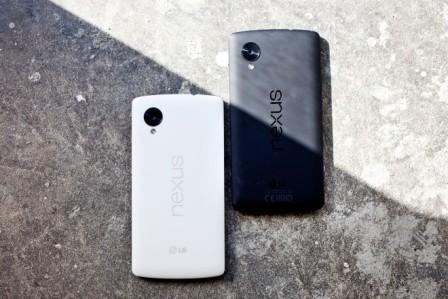Google showed off its new Android version 4.4 (or KitKat) operating system, running on a new flagship phone, the Nexus 5. Google uses its Nexus line to show off its new operating systems, and the device and OS are reflections of each other. Seen together, they reveal a Google that is boundlessly ambitious and aiming to take on the world with the things only it can do.
Sundar Pichai, who runs Android and Chrome for Google, says that KitKat has three major themes, which can be summarized as growth, design, and smarts. After crossing the billion activations mark, it now wants an operating system that works for the “next” billion people with Android devices. It wants something that’s beautiful and design-forward that’s pleasant to look at and intuitive to use. And it wants the experience of the phone to take advantage of what Google can do. All of these are major themes of the Nexus 5 as well.
Let’s start with the phone. The Nexus 5, developed with LG, has one driving purpose, which is to serve as a showcase for the operating system. To do that it needs to be something you want to use all the time, every day. Google mostly pulled this off. The phone is nice and light at 4.59 ounces. The specs are also solid. It has a 4.95-inch 1920 x 1080 HD display that has a 445 ppi pixel density, made from Corning Gorilla Glass 3. For taking images rather than viewing them, it has a 1.3 MP front-facing cam and 8MP rear camera. There’s a 2.26 GHz Qualcomm Snapdragon 800 CPU, 2 GB RAM, dual band Wi-Fi, NFC, and Bluetooth 4. All the stuff you’d expect. There are also nice extra touches as well, like an optical image stabilization feature lets you take sharp photos even with a shaky hand — this worked very well when we tried it out. To reach those next billion users, it’s launching in 10 countries, designed to run globally on all manner of networks. There is one model designed for North America, and another for the rest of the world. The Nexus 5 goes on sale today. Without a contract, the 16 GB model costs $349, and the 32 GB model is $399.
In terms of pure aesthetics, The Nexus 5 is very nice looking, but not striking in the way that, say, the HTC One or Gold iPhone 5S are. You can get it in white or black. There are no buttons across the bottom to add clutter. The logo melts into the backside. It’s not going to make people notice it, but it’s pleasant to look at.
Likewise, KitKat’s design has some pleasant features to help you make it prettier, and make it your own. You can rearrange your home screens (not just the apps on them, but the order of the screens themselves)–Google cited maybe having a weekday and weekend setup as a reason you may want to do this. When you’re playing music, the entire lockscreen will show album art.
But mostly, this phone is about KitKat, and KitKat is about What Google Knows.
The dialer, for example, takes advantage of Google’s database when making calls. Rather than looking up a number in search, and then dialing, you can simply say the name of a restaurant and Google will present you with options to call it, based on the ones in your area. If a business calls you, it shows the company’s name — both of these features work even if the business is not in your address book. The camera’s HDR function is fantastic in weirdly lit situations to get the most out of color and range. Google Hangouts offer a unified place for both SMS and chat, and make location sharing as easy as tapping the screen. Just hit a location icon in Hangouts to tell your friend where you are. Because onboard storage is finite, Google added API tools developers can hook into so users can pick and choose photos and files to send not just from the Gallery, but also cloud providers like Box or Google Drive. It means you can offload your photos and still easily access them from within apps.
Read more at Wired


